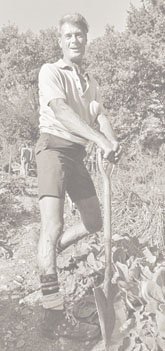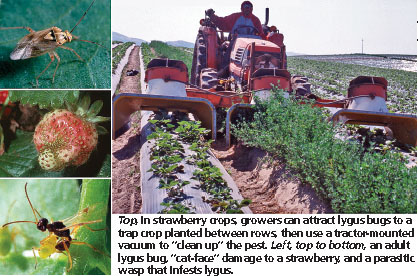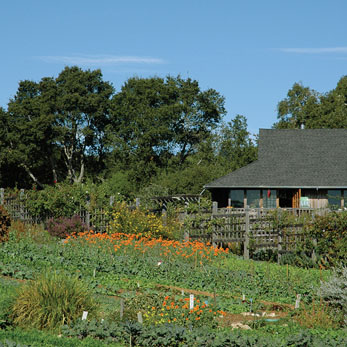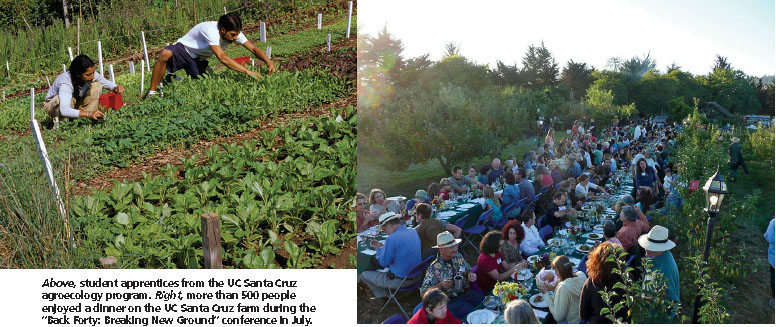All Issues
Breaking new ground: UC Santa Cruz celebrates sustainable innovation in farming, food systems
Publication Information
California Agriculture 61(4):152-155.
Published October 01, 2007
PDF | Citation | Permissions
Full text
In 1967, a charismatic English gardener — also an accomplished Shakespearean actor, painter, violinist and athlete — journeyed to California to establish an organic garden. On a steep hillside at UC Santa Cruz, Alan Chadwick broke ground for a student garden designed to demonstrate the biodynamic methods he had learned from his childhood tutor, Rudolf Steiner. Although he left after 5 years to establish similar projects elsewhere, Chadwick's innovative project took root. Today more than 1,200 graduates of the UC Santa Cruz farm and Garden apprenticeship program are often credited with pioneering what is now the mainstream, fast-growing organic food movement.
In 1980 the Agroecology Program was established within the UC Santa Cruz Division of Social Sciences to integrate the apprenticeship's hands-on focus with academic research; in 1994 the program's name was changed to the Center for Agroecology and Sustainable Food Systems at UC Santa Cruz (CASFS). CASFS focuses on ecological sustainability and social justice in food and agricultural systems; much of its research is in social sciences.
This year UC Santa Cruz celebrates the 40th anniversary of the Alan Chadwick Garden. In July, the “Back Forty: Breaking New Ground” conference provided hundreds of participants, many of them former apprentices, with tours of the Chadwick Garden, the 25-acre organic UC Santa Cruz farm, and local organic farms started by graduates; culinary celebrations with reflections on the early days at the Chadwick Garden, including a midsummer night's dinner in the apple orchard attended by nearly 600 people; and a symposium that featured graduates' innovative projects across the country and in Africa, and an overview of CASFS research.
Top, in strawberry crops, growers can attract lygus bugs to a trap crop planted between rows, then use a tractor-mounted vacuum to “clean up” the pest. Left, top to bottom, an adult lygus bug, “cat-face” damage to a strawberry, and a parasitic wasp that infests lygus.
Researchers working at the UC Santa Cruz farm (shown) and Alan Chadwick Garden helped to pioneer organic and sustainable growing methods. The Center for Agroecology and Sustainable Food Systems (CASFS) celebrated the garden's 40th anniversary this summer.
In symposium remarks, graduate Brian McElroy, organic business manager at Driscoll's Strawberry Associates, quoted a recent survey by the Perishables Group (fresh-food industry consultants) noting that 75% of Americans are now buying organic produce, at least on occasion. “The movement is still gaining momentum,” he said. “A quarter of Americans have started buying organic just in the last 12 months.”
Driscoll's, the world's largest shipper and packer of berries, “aims to be 15% organic by 2011,” McElroy said. Achieving that volume of organic berries from its growers depends in part on CASFS, he said. “We need the research to show whether something works or not.”
One-two punch at Lygus
The symposium highlighted organic agricultural research, which often involves collaborations among growers, UC Santa Cruz and other faculty, and UC Cooperative Extension farm advisors.
UC Santa Cruz entomologist Sean L. Swezey has developed methods to limit lygus bug damage in organically managed strawberry crops. “Lygus bugs are a real problem, because they're native and they feed on a wide variety of flowering plants,” Swezey says. “In the strawberry field, they feed on developing berries and cause gnarled, cat-faced berries that can't be sold on the fresh market.”
The research team is now recording a more than 50% reduction in lygus damage using a two-pronged approach — a trap crop and a parasitic wasp — at the trial site at Larry Eddings' Pacific Gold Farms, near Salinas. The results have encouraged Eddings, one of the largest organic strawberry producers on the Central Coast, to use the approach on his conventional strawberry crops also.
Above, student apprentices from the UC Santa Cruz agroecology program. Right, more than 500 people enjoyed a dinner on the UC Santa Cruz farm during the "Back Forty: Breaking New Ground" conference in July.
Swezey says it was Jim Cochran of Swanton Berry Farm in Davenport who originally collaborated in the research, funded by the U.S. Environmental Protection Agency. The idea was to lure lygus away from the strawberries by introducing a flowering plant as a trap-crop row directly into organic strawberry fields.
Continuing with a Biologically Integrated Farming Systems (BIFS) grant from UC Sustainable Agriculture Research and Education Program (UC SAREP), Swezey ran field trials of a number of different trap crops, including radish, alfalfa and alys-sum. Rows were planted in and around the edges of the strawberry fields, and when lygus bugs reached dense populations, the growers would remove the bugs with tractor-mounted vacuums. Alfalfa proved the most effective trap crop.
Researchers then tested the alfalfa trap crop approach on a portion of Eddings's organic strawberries. Devoting 2% to 3% of the strawberry field to alfalfa produced optimal results. Vacuuming only the trap crop and not the strawberries has slashed tractor time by more than 75% (in organically managed fields, the standard practice is to vacuum an entire field to remove lygus bugs). “That translates to lower labor and fuel costs, reduced emissions and preservation of the ‘good bugs’ that used to be vacuumed up with the lygus bugs,” Swezey says.
From the beginning of his lygus research, Swezey had also been looking to improve biological control with natural enemies of the bug in the trap-crop system, and possibly for the assistance of a highly selective natural enemy. Charlie Pickett, a biocontrol specialist with the California Department of Food and Agriculture's Biological Control Program, had imported the parasitic wasp Peristenus relictus for release in the Central Valley to help control lygus bug infestations in cotton fields. With Pickett's help, Swezey introduced the tiny wasp, which only targets the lygus bug, to the trial at Pacific Gold Farms.
In the last 3 years, the wasp has become established in the alfalfa trap crop and adjacent strawberries; it is living on its own without new releases. More than 60% of lygus bug nymphs in the trap crop have been parasitized by the wasps, and, in conjunction with the trap crop vacuuming, lygus damage to the strawberry crop has dropped more than 50%.
Blueberry crops promising
Tours of the UC Santa Cruz farm, which was started in 1971, included a stop at a blueberry trial. “If I had to plant 5 acres of blueberries right now, I'd plant ‘Southmoon’,” says Jim Leap, manager of the 25-acre CASFS organic farm. “It's far and away the best-tasting blueberry” among the 15 varieties being field-tested at the campus farm, “the yield looks good on it, and it's easy to pick,” he says.
Aware of Leap's interest in crops for small-scale organic growers, UCCE farm advisor Aziz Baameur approached him in 2003 with the idea of planting out a blueberry trial at UC Santa Cruz. In collaboration with UCCE farm advisor Mark Bolda, and with funding assistance from the UC Small Farm Center at UC Davis, researchers established a 0.16-acre field trial overlooking the ocean on the CASFS farm. The trial consists of 15 blueberry varieties with a total of 180 plants.
This is the first season that yield data were collected, and the numbers have not been crunched yet, but Leap is heartened by the trial so far. Though he had to put up bird netting over the entire trial area, it looks as if organic blueberries will grow well on the Central Coast. The berries sold exceptionally well at $4 per half-pint — $6,000 worth just at the UC Santa Cruz Market Cart (at the campus entrance), and they were a popular item in the farm's CSA (community-supported agriculture) shares.
“The challenge is that blueberries need acidic soil,” Leap says. Inexpensive sulfuric acid can be applied to conventionally managed blueberry fields, but Leap has had to buy vinegar approved by the Organic Materials Review Institute (OMRI) for use in certified organic systems. “We have been injecting vinegar with each irrigation. Before we planted, we applied a lot of soil sulfur and acidic soil amendments, but we still need the vinegar, and buying it in 55-gallon containers and trucking them in here might turn out to be prohibitively expensive,” he says. (Also, see California Agriculture April-June 2005, Vol. 59, No. 2, p. 65. )
The solution could be for the farm to make its own organic vinegar, Leap says. That's likely to be a job for the 6-month apprentices, who provide most of the labor for the farm. Forty years after the start of Chadwick's experiment, they continue to live on the edges of the well-cared-for fields at UC Santa Cruz, which has been dubbed the “Harvard of organic farming.”








